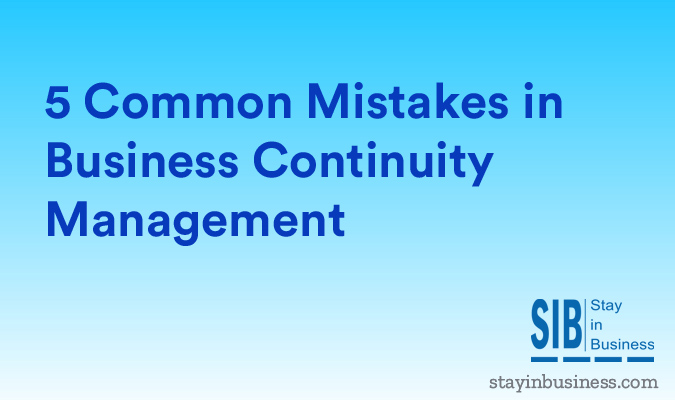5 Common Mistakes in Business Continuity Management

Business Continuity and Disaster Planning are at the forefront of every business media right now. It is indisputable that a proper and effective Business Continuity Management System is the difference between life and death of an organization when a crisis occurs. Unfortunately there are a few mistakes that I see time and time again from organizations that will actually make the disaster worse. If you can avoid these 5 mistakes, you will be far ahead of the curve when it comes to Business Continuity Management System.
1) Skip the basics.
There are three foundational principles that should govern your Disaster Recovery planning. Skimping on these three basics will make your disaster recovery plan need a disaster recovery plan of its own.
• Your data needs to be protected – Simple enough. Your data needs to be copied somewhere.
• Make sure your back up data is connected. – What use is it to have a backup of all of your data if you have no way to power it up and access it when crisis hits?
• Be clear on responsibilities. – if you are outsourcing any of your DR efforts, be very clear on who does what in the event of a disaster. The worst scenario I can think of would be to spend critical time and resources during the crisis arguing over the phone with your vendor on who is supposed to be handling a specific task.
You could run into the following potential problems if you failed to apply the foundational principals.
• Fail to create proper backups of critical data. Unfortunately the #1 issue during a crisis that reverberates time and time again goes something like “How in the world do we not have a backup of xxxx”
• Assuming that your vendor is taking care of something and then finding out when it is far too late that the task was never taken care of.
• Having viable servers sitting off site somewhere but no way to efficiently get the back up data that you have to those servers.
2) Data backup out of synch across the organization
While you may have the utmost faith in the incredible abilities of your IT department to turn an Atari into the matrix; data that is out of synch is simply a nightmare and may render much of your backup useless. Check and make sure that all of your backup data is synching up across the board. Trying to recover data that is backed up every night at 2am coupled with data that is on a 30 min auto-backup may inadvertently cause unnecessary delays and even irretrievable data.
3) Forget about the people
During a disaster it is highly likely that you will have a number of people moving over to a failover site. It is also likely that you will not be the only organization experiencing a disaster.
- These people will be hungry and thirsty….Do you have a means to provide food and water?
- What about sleeping…..cots are a small investment for the continuity of your organization.
- Communications…… how will your people talk to each other in an emergency?
- Comfort and distraction…… It doesn’t seem like much but a few decks of cards, extra blankets and a battery operated mp3 player loaded with light music can go a long way to making the situation easier for everyone involved.
4) Assume your company is first on everyone’s list
During a disaster the unfortunate truth is that most of your personnel will be unavailable. You may place your organization at the highest of your priorities list; and it’s very easy to look around at your dedicated staff and assume that you’ll be able to handle all of the things that will need to be done. The unfortunate reality is that during a real disaster, work will probably be the last thing on most of those people’s minds. When faced with an evacuation situation, worry about spouses, children, parents, personal property and personal safety; dedication to their company is just not going to rank high on most people’s priority list.
Consider outsourcing critical core business functions to reputable companies that specialize in disaster recovery. While it may seem an unnecessary expense, you will likely find the ROI well worth it in the long run.
5) Forget to adapt the plan as your organization changes
Again, reality check time. Your organization will change and grow over time. Your Business Continuity Management System needs to adapt to reflect those changes. In today’s business environment it seems like IT services change daily and if your Disaster Recovery plan has gone more than 6 months without a review, then it is likely going to be useless when faced with a real disaster.
Personnel changes also affect your business Continuity Management Systems. A common occurrence I see is that the people that were trained to do specific tasks during an emergency aren’t even employed there anymore and the new person wasn’t even aware that they were responsible for that task. An outdated and ineffective Disaster Recovery plan may actually be worse than no plan at all.
Proper Planning = Recovery
Keep these 5 things in mind while creating and implementing your Business Continuity and Disaster Recovery plans and you’ll be on your way to effective recovery when a real disaster strikes.
As a final note, consider how you can utilize all of your DR systems and resources when there isn’t a disaster. There is a multitude of ways that you can take advantage of the investment you’ve put into backup servers, data recovery points, off site locations, etc. get creative and don’t let all of those resources just sit idle.
Categories: Disaster Recovery Planning, DR Plans
